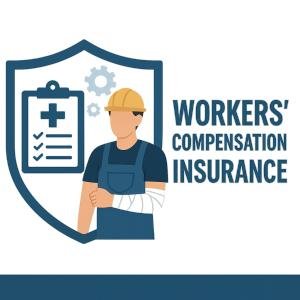
Affordable Workers’ Comp Insurance Options for Small Security Guard Firms
August 8, 2025
Home Health Agency Workers’ Comp Audit Preparation: No-Surprise Strategies
August 8, 2025The rising costs of workers’ compensation insurance present a significant challenge for security guard companies across Georgia. A key driver behind these escalating premiums is the prevalence of Occupational Safety and Health Administration (OSHA) violations within the industry. Understanding the top OSHA violations contributing to increased workers’ comp claims is essential for security firms aiming to improve workplace safety, reduce financial liabilities, and maintain competitive operational costs. This article examines the most common OSHA infractions impacting Georgia’s security guard workforce and offers insights into mitigating these risks to control insurance expenses effectively.
Table of Contents
- Top OSHA Violations Impacting Georgia Security Guard Industries
- Analyzing the Financial Consequences on Workers’ Compensation Premiums
- Implementing Targeted Safety Protocols to Mitigate Common Violations
- Strategic Recommendations for Employers to Lower Insurance Costs
- Q&A
- To Conclude
Top OSHA Violations Impacting Georgia Security guard Industries
the security guard industry in Georgia is increasingly facing financial strain due to recurring workplace safety lapses that directly influence workers’ compensation premiums. Among the most common infringements cited are inadequate hazard communication, insufficient personal protective equipment (PPE), and failure to properly train guards on site-specific safety protocols. These violations not only expose employees to preventable injuries but also drive up insurance costs as claims rise. Companies operating in this sector must prioritize compliance with OSHA standards to control escalating expenses and protect thier workforce from avoidable risks.
Addressing these challenges requires a structured approach emphasizing regular safety audits, ongoing training, and proper documentation.Below is an overview of critical OSHA violations frequently encountered, which Georgia security firms should tackle proactively:
- hazard Communication Deficiencies: Lack of clear labeling and safety data sheets for hazardous materials used on premises.
- Inadequate PPE Provision: Failure to supply appropriate protective gear such as gloves, vests, and eye protection.
- improper risk Assessment: Neglecting to conduct thorough site evaluations to identify and mitigate potential hazards.
- Insufficient Training: Limited or outdated training programs leading to unsafe operational practices.
| Violation Type | Impact on Workers’ Comp | Recommended Action |
|---|---|---|
| hazard Communication | High claims due to chemical exposures | Regular labeling audits and employee briefings |
| PPE Shortcomings | Increased injury frequency | Ensure availability and correct use of PPE |
| Training Deficiencies | Higher accident rates | Implement comprehensive, recurrent training programs |
Analyzing the Financial Consequences on Workers’ Compensation Premiums
The surge in OSHA violations within Georgia’s security guard industry has a direct and significant impact on workers’ compensation premiums. Insurance providers closely scrutinize workplace safety records when assessing risk, and an increase in violations signals higher potential for claims. This ultimately leads to elevated premium costs for security firms that fail to maintain compliance. Companies with repeated infractions not only encounter financial strain from rising insurance fees but also face the challenge of budgeting for unexpected claim payouts resulting from workplace injuries tied to these violations.
To illustrate the premium impact, consider the following comparative analysis of workers’ compensation rates in Georgia security firms with varying safety compliance levels:
| compliance Level | Average Premium Increase | Claim Frequency |
|---|---|---|
| Full OSHA Compliance | +3% | Low |
| Moderate Violations | +15% | Moderate |
| Frequent/Severe Violations | +40% or more | High |
This data underscores the necessity for proactive safety management to curb premium inflation. Key measures include:
- Conducting regular safety audits to identify and remediate potential hazards before violations occur.
- Investing in comprehensive training programs that focus on OSHA compliance relevant to security operations.
- Implementing strong incident reporting systems, facilitating prompt corrective actions to minimize claim frequency.
implementing Targeted Safety Protocols to Mitigate Common Violations
Establishing precise and targeted safety protocols tailored to the unique challenges faced by security guard personnel in Georgia is essential to curtail the frequent OSHA violations that inflate workers’ compensation premiums. By focusing on key risk areas such as proper use of personal protective equipment (PPE), clear communication channels for incident reporting, and rigorous training on hazard recognition, employers can significantly reduce injury rates. Regular audits and feedback loops further ensure that safety measures evolve alongside operational changes, embedding a culture of compliance and proactive risk management.
Practical steps for implementation include:
- Customizing training modules to reflect real-world scenarios security guards encounter
- Integrating technology for real-time hazard detection and response
- Scheduling frequent site walkthroughs with safety specialists
- Promoting employee engagement through safety incentive programs
| Protocol Element | Impact on Violation Reduction | Implementation Ease |
|---|---|---|
| PPE Compliance Checks | High | Moderate |
| Incident Reporting App | Medium | High |
| Scenario-Based Training | High | Medium |
| Safety Incentive Programs | Medium | High |
Strategic recommendations for Employers to Lower Insurance Costs
Employers play a critical role in managing workers’ compensation expenses by proactively addressing the root causes of OSHA violations. A robust safety culture begins with comprehensive employee training programs focused on hazard recognition and prevention tailored to security personnel’s unique work environments. Implementing routine safety audits and compliance checks ensures that workplace practices align with regulatory standards and industry best practices, reducing the likelihood of costly incidents. Encouraging open communication channels further empowers security teams to report unsafe conditions promptly, fostering a proactive rather than reactive approach to safety.
Cost-effective strategies also include leveraging data analytics to identify high-risk operations and scheduling regular ergonomic assessments to minimize physical strain injuries prevalent among security guards. Additionally, employers should consider adopting advanced personal protective equipment (PPE) and technology-enabled monitoring systems to enhance onsite safety.The following summary table highlights key initiatives and their potential impact on premium reduction:
| Strategic Initiative | Expected Outcome | Impact on Premiums |
|---|---|---|
| Employee Safety training | Improved hazard awareness | 15% reduction |
| Regular Safety Audits | Early violation detection | 20% reduction |
| Ergonomic Assessments | Lower injury rates | 10% reduction |
| advanced PPE Adoption | Enhanced protection | 12% reduction |
Q&A
Q&A: Top OSHA Violations Spiking Georgia Security Guard Workers’ comp Premiums
Q1: What recent trend has been observed regarding OSHA violations among security guard companies in Georgia?
A1: there has been a noticeable increase in OSHA violations within Georgia’s security guard industry. These violations predominantly relate to inadequate safety training, failure to use personal protective equipment (PPE), and improper hazard communication. This spike has directly impacted workers’ compensation (workers’ comp) premiums for security firms across the state.
Q2: Which specific OSHA violations are most frequently cited in Georgia’s security guard sector?
A2: The most common violations include lack of proper PPE such as high-visibility vests, insufficient hazard communication regarding security threats, failure to conduct safety training specific to workplace violence or hazardous environments, and non-compliance with ergonomics and workplace injury prevention standards.
Q3: How do these OSHA violations influence workers’ compensation premiums for security guard employers?
A3: OSHA violations signal increased workplace risk, prompting insurance providers to reassess and often raise workers’ comp premiums to offset the higher likelihood of claims. Frequent or severe violations can drive premiums significantly higher, affecting the company’s operational costs and profitability.
Q4: What are the potential consequences for security guard companies that fail to address these OSHA violations?
A4: Beyond increased insurance premiums, companies face fines, legal liabilities, reputational damage, and potential disruptions in service contracts. Moreover, unaddressed safety hazards can lead to higher injury rates among guards, further exacerbating costs and regulatory scrutiny.
Q5: What corrective measures can Georgia security companies implement to reduce OSHA violations and control premium hikes?
A5: Companies should invest in comprehensive safety training programs tailored to the security industry, enforce strict PPE usage, regularly audit workplace conditions for hazards, and maintain clear communication protocols. Partnering with occupational health experts and staying current with OSHA regulations also helps mitigate risks.
Q6: How does improving OSHA compliance benefit the overall buisness performance of security guard firms?
A6: Enhanced compliance reduces workplace injuries, which lowers workers’ comp claim frequency and related costs. This stability can lead to reduced insurance premiums, improved employee morale, and stronger client trust-all contributing to a more sustainable and competitive business model.
Q7: Are there resources available for Georgia security firms to stay updated on OSHA standards?
A7: Yes, OSHA provides numerous resources including training materials, compliance assistance programs, and consultation services. additionally, industry associations and local safety consultants offer specialized guidance on adhering to safety regulations pertinent to the security sector.
This Q&A aims to help Georgia security guard companies understand how OSHA violations impact workers’ comp premiums and highlight practical steps for improving workplace safety and controlling costs.
To Conclude
addressing the top OSHA violations contributing to the rise in workers’ compensation premiums for Georgia’s security guard industry is not only a regulatory imperative but also a strategic business decision. Proactively enhancing workplace safety protocols, investing in comprehensive training, and fostering a culture of compliance can mitigate risks, reduce costly claims, and ultimately protect both employees and employers. By prioritizing OSHA standards, security companies can better control premium costs, improve operational efficiency, and secure a safer working environment-a critical step toward sustainable growth in a highly competitive market.
“This content was generated with the assistance of artificial intelligence. While we strive for accuracy, AI-generated content may not always reflect the most current information or professional advice. Users are encouraged to independently verify critical information and, where appropriate, consult with qualified professionals, lawyers, state statutes and regulations & NCCI rules & manuals before making decisions based on this content.







